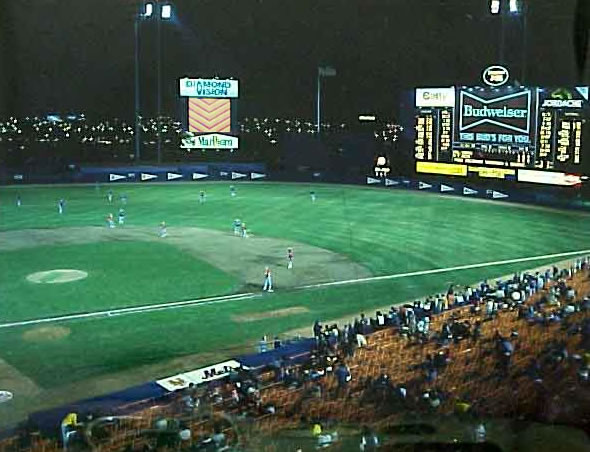|
Video Weavings on the first Diamond Vision giant video screen at Shea Stadium, New York Mets Night Game (1982) |
"My work is to make something beautiful with technology. I believe in spiritual technology. Video Weavings is a link between the modern (video) and the ancient (weaving) technologies. Video Weavings are based on poetic mathematical rhymes, or algorithms, visualized in real time on the warp and weft of video's horizontal and vertical scanning electron beams, color phosphors, plasma cells, and LCD pixels."
"In my Video Weavings, millions of patterns appear, many of which resemble or replicate the same patterns found in textiles woven by ancient peoples such as the Pueblos of the southwestern North American continent, the Nairobi of Africa, the Hindu of India, the Aborigines of Australia, and by many peoples in China and Japan."
"The idea, then, for Video Weavings is to reflect upon, acknowledge and honor the links between the most modern electronic visual display systems, and the ancient art of weaving, though the common connection of the matrix."
From an essay by Stephen Beck appearing in the catalog for the Info Art exhibition at the Kwang-Ju Biennale in Korea.
The Beck Digital Video Weaver System Technology: A Brief History
The Beck Video Weaver design began in 1973 as an extension of the Beck Direct Video Synthesizer. The initial design combined magic square mathematics with color sequencing by means of a series of 74193 TTL logic chips, which are 4-bit up/down counters.
The design synchronized a series of cascoded counters to video pixel clocks, which were derived from the NTSC color subcarrier frequency of 3.579545 MHz and then fed into counters synchronized to the video horizontal and vertical sync timings. Further counter stages set time base tempos for the animation.
The three sets of 4-bit counters generated a 12-bit digital value, which was mapped to variable analog colorizer channels in the Beck Direct Video Synthesizer. As a result, the device could generate millions of display colors, many of which exceeded or violated the strict NTSC technical values for broadcast or recordable video signals.
As with many of the Beck Direct Video Synthesis colors, including negative colors, images seen in performances contained colors that could not be broadcast or recorded.
The counters design also included numerous taps and feedbacks to reverse the up/down counting sequences within the video frame. This in turn resulted in numerous symmetries as well as in tessellations of the colors.
Video was still largely a pre-digital, all analog world when Beck introduced the Video Weavings works, and while the artist made many videotape recordings of Video Weavings at the time, one particular piece was published and distributed. The rest remain unpublished and in Beck's private archive collection.
Video Weavings was first screened to the public at the San Francisco Museum of Modern Art in 1974. The audience response was enthusiastic because no one had ever seen digital video synthesized before. Beck had also composed some Video Weavings for the Videloa display unit constructed by Don Hallock at the NCET in 1973 (See videospace page.).
As a result of a grant from The Rockefeller Foundation, Beck along with a few other American video artists attended the INPUT 78 World Public Television conference in Milan, Italy, which led to Beck's Video Weavings being licensed by an Italian textile company for manufacturing its fabrics.
The year 1982 marked the appearance of giant video screens, based on gas discharge plasma bulbs. The Mitsubishi Diamond Vision screens were 30 feet wide, and when an executive from Mitsubishi noticed a chevron-shaped diamond passage in Beck's Video Weavings at the Tokyo Museum of Art's "Video Tokyo" exhibition, his firm licensed the artist's work for a full season's display on the first Mitsubishi Diamond Vision screen at Shea Stadium in New York for the New York Mets.
“The concept of “Video Weavings” being shown on the giant Diamond Vision screen at Major League Baseball games at Shea Stadium was very appealing to me, as one means to reach a different audience from the art museums.”
“Video Weavings” was broadcast nationally on TV in 1976 on the PBS-TV network as part of a the WNET TV Labs “Video Visionaries” series, produced by David Loxton.
The work was also presented on multiple CRT video screens in the window displays of Bergdorf Goodman on Fifth Avenue in New York City, as part of their spring textiles presentations.
